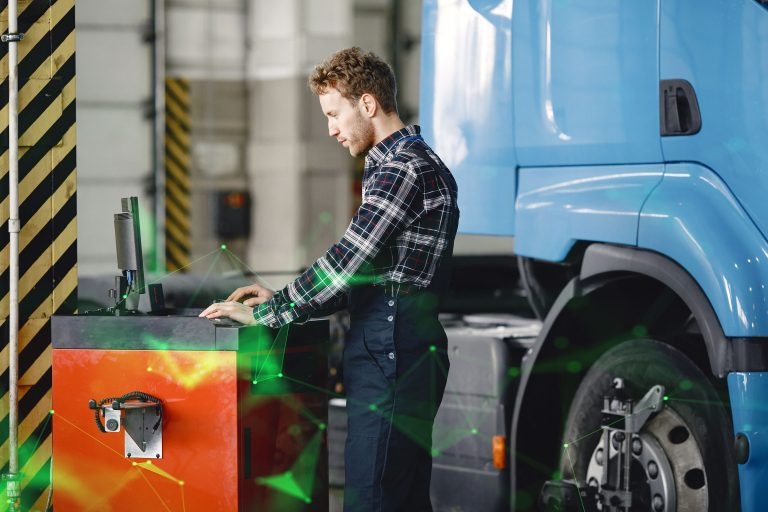The Importance of Vehicle Checks.
Regular vehicle checks keep your fleet in top shape and lower the chance of breakdowns or accidents. By doing these checks, you can spot any issues early on, staying safe on the road and meeting legal standards.
HGV Walkaround Check.
A Heavy Goods Vehicle (HGV) walkaround check is a visual inspection performed before starting a trip. This check helps ensure the vehicle meets legal standards and is safe to operate. It includes verifying lights, tires, mirrors, and other critical components.
What to Look For:
During the walk around check, drivers should look for visible damage, leaks, or worn-out parts. Check the tires for proper inflation and tread depth, inspect mirrors for cracks, and ensure that lights are functioning correctly.
The Role of the Driver.
Drivers are super important for keeping cars safe. By checking things carefully, they can find problems and tell their transport manager, so repairs get done fast.
Legal Requirements
The DVSA says HGV drivers have to do certain checks. If they don't, they could get fined, have their vehicle taken away, or even be stopped from driving.

HGV Vehicle Checks.
In addition to the walkaround check, more thorough HGV vehicle checks are necessary to maintain safety and compliance. These include inspecting the engine, brakes, and other critical systems.
Engine Inspection.
Regularly check the engine oil level, coolant, and other fluids. Ensure that there are no leaks and that all components are in good working order. This helps prevent engine failure and extends the vehicle's lifespan.
Brake System.
The braking system is vital for vehicle safety. Check the parking brake, brake pads, and fluid levels regularly. Any signs of wear or malfunction should be addressed immediately.
Lights and Indicators.
Properly functioning lights and indicators are crucial for road safety. Check all lights, including headlights, brake lights, and turn signals, to ensure they are working correctly.
Vehicle Check Sheet.
A vehicle check sheet is a handy tool that helps drivers and transport managers keep track of inspections. It lists all the essential checks and allows for easy documentation of any issues found.
Creating a Check Sheet.
When creating a vehicle check sheet, include sections for each part of the vehicle that needs to be inspected. This ensures that no critical component is overlooked during the inspection process.
Benefits of Using a Check Sheet.
Using a check sheet helps maintain consistency and thoroughness in vehicle inspections. It also provides a record of checks performed, which can be useful for compliance and maintenance purposes.
Customizable Templates.
Customizable templates are available online, allowing you to tailor the check sheet to your specific needs. These templates can be printed out or used digitally for convenience.

Vehicle Checklist Template.
A vehicle checklist template is a valuable resource for drivers and transport planners. It provides a structured way to conduct daily checks and ensures that all necessary inspections are completed.
Key Components.
The checklist should include key components such as tires, lights, mirrors, fluids, and brakes. Each item should have a checkbox for easy tracking and a space for notes.
Daily Use.
Using the checklist daily helps catch potential issues early, preventing costly repairs and enhancing vehicle safety. It also reinforces good habits and ensures compliance with legal requirements.
Digital vs. Paper.
While traditional paper checklists are still widely used, digital checklists like the one Geo2 has, offer several advantages. They can be easily updated, stored, and shared, making them a convenient option for modern fleet management.
Daily Vehicle Checklist.
A daily vehicle checklist is essential for maintaining road safety and vehicle reliability. It helps drivers perform consistent inspections and identify any defects before starting their trip.
Morning Routine.
Incorporate the daily checklist into your morning routine. This ensures that the vehicle is safe and ready for the day's operations. Regular checks build confidence in the vehicle's performance.
Addressing Defects.
If any defects are found during the inspection, they should be reported immediately and addressed before the vehicle is driven. This helps prevent accidents and ensures compliance with safety standards.
Collaboration with Transport Managers.
Transport managers play a vital role in vehicle maintenance. They should work closely with drivers to ensure that all issues are resolved promptly and that the vehicle remains in top condition.
Vehicle Safety and Compliance.
Vehicle safety and compliance are critical for drivers and transport planners. Regular checks help maintain the vehicle's performance and ensure that it meets legal standards.
Importance of Compliance.
Compliance with safety regulations is not just about avoiding fines; it's about protecting lives. Regular inspections help prevent accidents and ensure that the vehicle is safe to drive.
Role of Fleet Management.
Fleet management plays a significant role in ensuring compliance. By doing regular checks and keeping up with maintenance, fleet managers can make sure vehicles stay in great shape and are less likely to break down.
DVSA Inspections.
DVSA officers may conduct random inspections to ensure compliance. Being prepared with a well-maintained vehicle and proper documentation can help you pass these inspections without any issues.
FREQUENTLY ASKED QUESTIONS
A vehicle checklist is a simple list to check important parts of a vehicle regularly. It helps keep things safe and working well by spotting problems early.
Related posts

What is Fleet Management and the Role of a Fleet Manager?
Managing a fleet of vehicles can feel like juggling a dozen balls at once. Whether you're new to fleet management or looking to refine your existing processes, this guide will provide you with valuable insights to streamline operations and enhance efficiency. We'll explore what fleet management entails, the crucial role of a fleet manager, and how technology is revolutionizing the industry.

Own Fleet or Carriers: Which is Best for Your Business?
In logistics and supply chain management, deciding whether to own a fleet or use carriers is a crucial choice. This choice can have significant implications for everything from cost efficiency to customer satisfaction. In this blog post, we’ll explore the pros and cons of each option to help you determine the best choice for your business.

What is Grey Fleet Management?
This management area involves vehicles—ranging from cars and motorcycles to scooters and bicycles—owned by employees but used for work. These vehicles occupy a unique position, straddling the line between personal ownership and professional use, often leading to a lack of regulation akin to that of company-owned fleets.
